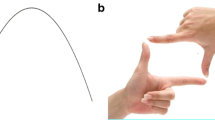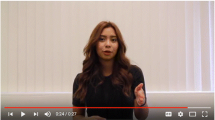Abstract
Spontaneous gesture produced in conjunction with speech is considered as both a source of data about mathematical thinking, and as an integral modality in communication and cognition. The analysis draws on a corpus of more than 200 gestures collected during 3 h of interviews with prospective elementary school teachers on the topic of fractions. The analysis examines how gestures express meaning, utilizing the framework of cognitive linguistics to argue that gestures are both composed of, and provide inputs to, conceptual blends for mathematical ideas, and a standard typology drawn from gesture studies is extended to address the function of gestures within mathematics more appropriately.






Similar content being viewed by others
References
Alibali, M. W., & diRusso, A. (1999). The function of gesture in learning to count: More than keeping track. Cognitive Development, 14, 37–56.
Alibali, M. W., Kita, S., & Young, A. (2000). Gesture and the process of speech production: We think, therefore we gesture. Language and Cognitive Processes, 15, 593–613.
Arzarello, F. (2006). Semiosis as a multimodal process. Revista Latinoamericana de Investigacion en Matemática Educativa, Numero Especial, 267–299.
Bazzini, L. (1991). From grounding metaphors to technological devices: A call for legitimacy in school mathematics. Educational Studies in Mathematics, 47, 259–271.
Behr, M. J., Harel, G., Post, T., & Lesh, R. (1992). Rational number, ratio, and proportion. In D. A. Grouws (Ed.) Handbook of research on mathematics teaching and learning (pp. 296–333). New York: Macmillan.
Church, R. B., & Goldin-Meadow, S. (1986). The mismatch between gesture and speech as an index of transitional knowledge. Cognition, 23, 43–71.
Cobb, P., Gravemeijer, K., Yackel, E., McClain, K., & Whitenack, J. (1997). Symbolizing and mathematizing: The emergence of chains of signification in one first-grade classroom. In D. Kirshner, & J. A. Whitson (Eds.) Situated cognition theory: Social, semiotic, and neurological perspectives (pp. 151–233). Mahwah, NJ, USA: Lawrence Erlbaum.
Edwards, L. (2003). A natural history of mathematical gesture. Paper presented at the Annual Meeting of the American Educational Research Association Annual Meeting, Chicago, April.
Fauconnier, G., & Turner, M. (2002). The way we think: Conceptual blending and the mind’s hidden complexities. New York: Basic Books.
Goldin-Meadow, S. (2003). Hearing gestures: How our hands help us think. Chicago: University of Chicago Press.
Goldin-Meadow, S., Kim, S., & Singer, M. (1999). What the teacher’s hands tell the student’s mind about math. Journal of Educational Psychology, 91(4), 720–730.
Goldin-Meadow, S., & Singer, M. (2003). From children’s hands to adults’ ears: Gesture’s role in teaching and learning. Developmental Psychology, 39, 509–520.
Graham, T. (1999). The role of gesture in children’s learning to count. Journal of Experimental Child Psychology, 74, 333–355.
Hutchins, E. (2005). Material anchors for conceptual blends. Journal of Pragmatics, 37, 1555–1577.
Jensen, G. (2003). Arithmetic for teachers: With applications and topics from geometry. Providence, RI: American Mathematical Society.
Kendon, A. (1997). Gesture. Annual Review of Anthropology, 26, 109–128.
Kita, S. (2000). How representational gestures help speaking. In D. McNeill (Ed.) Language and gesture (pp. 162–185). Cambridge: Cambridge University Press.
Kita, S. (Ed.). (2003). Pointing: Where language, culture and cognition meet. Mahwah, NJ, USA: Lawrence Erlbaum.
Lakoff, G., & Núñez, R. (2000). Where mathematics comes from: How the embodied mind brings mathematics into being. New York: Basic Books.
Lamon, S. (1999). Teaching fractions and rational numbers for understanding: Essential content knowledge and instructional strategies for teachers. Mahwah, NJ, USA: Lawrence Erlbaum.
Lee, D. (2001). Cognitive linguistics: An introduction. Oxford: Oxford University Press.
Mack, N. K. (1990). Learning fractions with understanding: Building on informal knowledge. Journal for Research in Mathematics Education, 21(1), 16–32.
McNeill, D. (1992). Hand and mind: What gestures reveal about thought. Chicago: University of Chicago Press.
McNeill, D. (Ed.) (2000). Language and gesture. Cambridge: Cambridge University Press.
McNeill, D. (2005). Gesture and thought. Chicago: University of Chicago Press.
Nemirovsky, R., Tierney, C., & Wright, T. (1998). Body motion and graphing. Cognition and Instruction, 16(2), 119–172.
Núñez, R. (2006). Do real numbers really move? Language, thought, and gesture: The embodied cognitive foundations of mathematics. In R. Hersh (Ed.) 18 unconventional essays on the nature of mathematics (pp. 160–181). New York: Springer.
Nuñéz, R., Edwards, L., & Matos, J. (1999). Embodied cognition as grounding for situatedness and context in mathematics education. Educational Studies in Mathematics, 39(1–3), 45–65.
Parrill, F., & Sweetser, E. (2004). What we mean by meaning. Gesture, 4(2), 197–219.
Perry, M., Church, R. B., & Goldin-Meadow, S. (1988). Transitional knowledge in the acquisition of concepts. Cognitive Development, 3, 359–400.
Pimm, D. (1981). Metaphor and analogy in mathematics. For the Learning of Mathematics, 2, 47–50.
Presmeg, N. (1992). Prototypes, metaphors, metonymies and imaginative rationality in high school mathematics. Educational Studies in Mathematics, 23(6), 595–610.
Presmeg, N. (1997). Reasoning with metaphors and metonymies in mathematical learning. In L. D. English (Ed.) Mathematical reasoning: Analogies, metaphors and images (pp. 267–279). Mahwah, NJ, USA: Lawrence Erlbaum.
Presmeg, N. (2006). Semiotics and the “connections” standard: Significance of semiotics for teachers of mathematics. Educational Studies in Mathematics, 61, 163–182.
Radford, L. (2002). The seen, the spoken and the written: A semiotic approach to the problem of objectification of mathematical knowledge. For the Learning of Mathematics, 22(2), 14–23.
Radford, L. (2003). Gestures, speech and the sprouting of signs. Mathematical Thinking and Learning, 5(1), 37–70.
Radford, L., Demers, S., Guzmán, J., & Cerulli, M. (2003). Calculators, graphs, gestures, and the production of meaning. In N. Pateman, B. Dougherty, & J. Zilliox (Eds.) Proceedings of the 2003 Joint Meeting of PME and PMENA, (Vol.4, pp. 55–62). Honolulu, HI, USA: University of Hawai’i.
Reynolds, F., & Reeve, R. (2002). Gesture in collaborative mathematics problem solving. Journal of Mathematical Behavior, 20, 447–460.
Robutti, O. (2006). Motion, technology, gesture in interpreting graphs. International Journal of Computer Algebra in Mathematics Education, 13, 117–126.
Sfard, A. (1991). On the dual nature of mathematical conceptions: Reflections on processes and objects as different sides of the same coin. Educational Studies in Mathematics, 22, 1–36.
Smith, N. (2003). Gestures and beyond. A.B. Honors Thesis, University of California at Berkeley. Retrieved July 8 2008, from http://www.icsi.berkeley.edu/∼njs/thesis/.
Varela, F., Thompson, E., & Rosch, E. (1991). The embodied mind: Cognitive science and human experience. Cambridge, MA: MIT Press.
Walkerdine, V. (1988). The mastery of reason. London: Routledge.
Acknowledgements
The research reported in this article was supported by a LaSallian Scholar grant from Saint Mary’s College; the writing took place during a scholarly leave at the University of California at San Diego funded by the Spencer Grant #200700151.
Author information
Authors and Affiliations
Corresponding author
Electronic supplementary material
Below is the link to the electronic supplementary material.
(MOV 1.10 MB)
(MOV 1.06 MB)
Rights and permissions
About this article
Cite this article
Edwards, L.D. Gestures and conceptual integration in mathematical talk. Educ Stud Math 70, 127–141 (2009). https://doi.org/10.1007/s10649-008-9124-6
Received:
Accepted:
Published:
Issue Date:
DOI: https://doi.org/10.1007/s10649-008-9124-6




